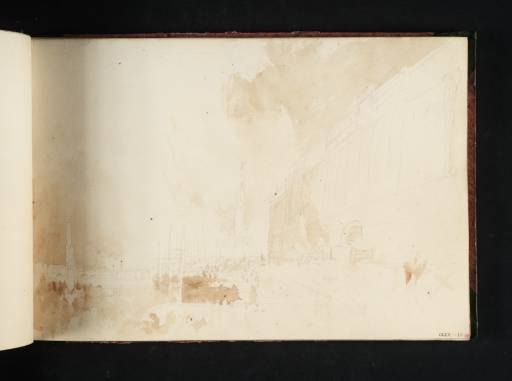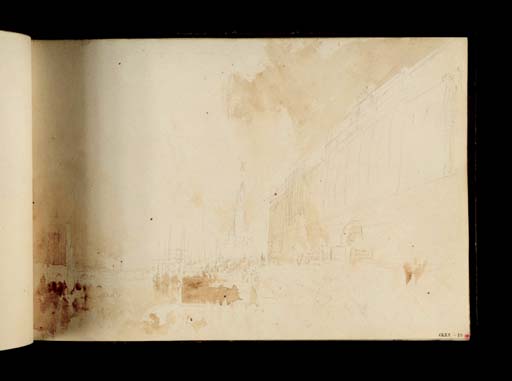Joseph Mallord William Turner The Custom House, London c.1820
Image 1 of 2
Joseph Mallord William Turner,
The Custom House, London
c.1820
Joseph Mallord William Turner 1775–1851
Folio 11 Recto:
The Custom House, London circa 1820
D13825
Turner Bequest CLXX 10
Turner Bequest CLXX 10
Pencil and watercolour on off-white wove paper, 177 x 256 mm
Inscribed in red ink by John Ruskin ‘10’ bottom right
Stamped in black ‘CLXX – 10’ bottom right
Inscribed in red ink by John Ruskin ‘10’ bottom right
Stamped in black ‘CLXX – 10’ bottom right
Accepted by the nation as part of the Turner Bequest 1856
References
1909
A.J. Finberg, A Complete Inventory of the Drawings of the Turner Bequest, London 1909, vol.I, p.493, CLXX 10, as ‘Venice. Sepia.’.
1974
Martin Butlin, Andrew Wilton and John Gage, Turner 1775–1851, exhibition catalogue, Royal Academy, London 1974, p.64 under cat.119.
This pencil drawing and wash sketch is of the Custom House near London Bridge. It was made from the quayside just to the east towards the Tower of London, and the view west is towards London Bridge at the left with the steeple of St Magnus-the-Martyr at the centre of the page. Turner’s sketch also includes boats moored at the quay in the area known as the Pool of London, and scribbles on the quayside probably represent people.
The Custom House dealt with the administration of trade and the arrival of foreign ‘aliens’ to the city. The building in Turner’s sketch was completed in 1817 to the designs of David Laing, although it partially collapsed in 1825, with the frontage having to be rebuilt under the direction of Sir Robert Smirke. Eric Shanes has suggested that Turner’s association with Smirke may have prompted his painting a later watercolour of the subject (see below), but the original façade is depicted in that work and these sketches, suggesting an earlier date.1
The sketch is executed in pencil and brown watercolour wash. Faint pencil lines provide the basic composition, and the sky (except for the clouds), the water and the shadows were depicted in wash.
The sketch relates to a number of other studies as Andrew Wilton has noted,2 and to a watercolour of The Custom House, London Bridge, circa 1825 (Vancouver Art Gallery),3 which was later engraved by J.C. Allen (1827). That painting was based on a number of sketches including this one, which is very close to the general composition but is taken from a more oblique angle to the Custom House and does not include St Paul’s or the Monument. The sketch on folio 12 (D13826; CLXX 11) provides the viewpoint, and contains several of the features of the watercolour, and elements of a sketch in the Tabley sketchbook No.3 (Tate D07041; Turner CV 41a) were also incorporated in the watercolour.
There is also a watercolour study of a similar view pasted into the back of this sketchbook on folio 43 (D13858; CLXX 42), which Finberg notes was ‘not part of this book, [but] is placed here because it is a study for the same subject as that on p.11’ (folio 12). Finberg misidentified these sketches as ‘the Canale di S. Marco, Venice.’4 Watercolour ‘beginnings’ on folios 13 and 14 (D13827, D13828; CLXX 12, 13) may also relate to the subject. Wilton has linked a watercolour drawing in the Hesperides sketchbook (Tate D05785; Turner Bequest XCIII 12) to these sketches and Turner returned to London Bridge around 1823 or 1824 to sketch it during the construction of the new bridge, drawings in the Old London Bridge sketchbook therefore include cranes in them (e.g. Tate D17848; Turner Bequest CCV 8).
Verso:
Blank
Thomas Ardill
August 2009
How to cite
Thomas Ardill, ‘The Custom House, London c.1820 by Joseph Mallord William Turner’, catalogue entry, August 2009, in David Blayney Brown (ed.), J.M.W. Turner: Sketchbooks, Drawings and Watercolours, Tate Research Publication, December 2012, https://www


